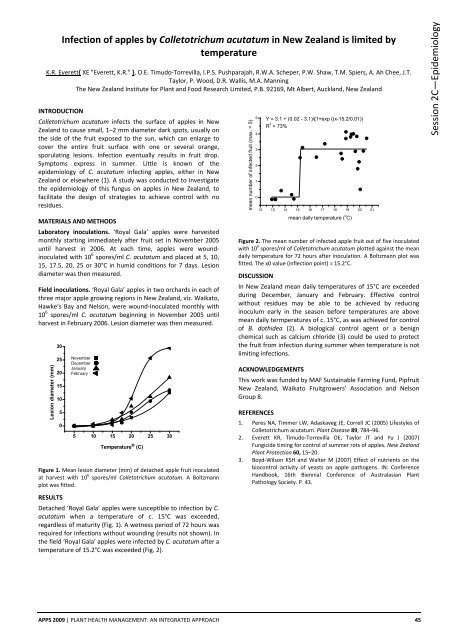View PDF - Australasian Plant Pathology Society
View PDF - Australasian Plant Pathology Society
View PDF - Australasian Plant Pathology Society
You also want an ePaper? Increase the reach of your titles
YUMPU automatically turns print PDFs into web optimized ePapers that Google loves.
Infection of apples by Colletotrichum acutatum in New Zealand is limited by<br />
temperature<br />
K.R. Everett{ XE "Everett, K.R." }, O.E. Timudo‐Torrevilla, I.P.S. Pushparajah, R.W.A. Scheper, P.W. Shaw, T.M. Spiers, A. Ah Chee, J.T.<br />
Taylor, P. Wood, D.R. Wallis, M.A. Manning<br />
The New Zealand Institute for <strong>Plant</strong> and Food Research Limited, P.B. 92169, Mt Albert, Auckland, New Zealand<br />
INTRODUCTION<br />
Colletotrichum acutatum infects the surface of apples in New<br />
Zealand to cause small, 1–2 mm diameter dark spots, usually on<br />
the side of the fruit exposed to the sun, which can enlarge to<br />
cover the entire fruit surface with one or several orange,<br />
sporulating lesions. Infection eventually results in fruit drop.<br />
Symptoms express in summer. Little is known of the<br />
epidemiology of C. acutatum infecting apples, either in New<br />
Zealand or elsewhere (1). A study was conducted to investigate<br />
the epidemiology of this fungus on apples in New Zealand, to<br />
facilitate the design of strategies to achieve control with no<br />
residues.<br />
MATERIALS AND METHODS<br />
Laboratory inoculations. ‘Royal Gala’ apples were harvested<br />
monthly starting immediately after fruit set in November 2005<br />
until harvest in 2006. At each time, apples were woundinoculated<br />
with 10 6 spores/ml C. acutatum and placed at 5, 10,<br />
15, 17.5, 20, 25 or 30°C in humid conditions for 7 days. Lesion<br />
diameter was then measured.<br />
Field inoculations. ‘Royal Gala’ apples in two orchards in each of<br />
three major apple growing regions in New Zealand, viz. Waikato,<br />
Hawke’s Bay and Nelson, were wound‐inoculated monthly with<br />
10 6 spores/ml C. acutatum beginning in November 2005 until<br />
harvest in February 2006. Lesion diameter was then measured.<br />
Lesion diameter (mm)<br />
30<br />
25<br />
20<br />
15<br />
10<br />
5<br />
0<br />
November<br />
December<br />
January<br />
February<br />
5 10 15 20 25 30<br />
Temperature o (C)<br />
Figure 1. Mean lesion diameter (mm) of detached apple fruit inoculated<br />
at harvest with 10 6 spores/ml Colletotrichum acutatum. A Boltzmann<br />
plot was fitted.<br />
RESULTS<br />
Detached ‘Royal Gala’ apples were susceptible to infection by C.<br />
acutatum when a temperature of c. 15°C was exceeded,<br />
regardless of maturity (Fig. 1). A wetness period of 72 hours was<br />
required for infections without wounding (results not shown). In<br />
the field ‘Royal Gala’ apples were infected by C. acutatum after a<br />
temperature of 15.2°C was exceeded (Fig. 2).<br />
mean number of infected fruit (max. = 5)<br />
5<br />
4<br />
3<br />
2<br />
1<br />
0<br />
Y = 3.1 + (0.02 - 3.1)/(1+exp ((x-15.2/0.01))<br />
R 2 = 73%<br />
12 13 14 15 16 17 18 19 20 21<br />
mean daily temperature ( o C)<br />
Figure 2. The mean number of infected apple fruit out of five inoculated<br />
with 10 6 spores/ml of Colletotrichum acutatum plotted against the mean<br />
daily temperature for 72 hours after inoculation. A Boltzmann plot was<br />
fitted. The x0 value (inflection point) = 15.2°C.<br />
DISCUSSION<br />
In New Zealand mean daily temperatures of 15°C are exceeded<br />
during December, January and February. Effective control<br />
without residues may be able to be achieved by reducing<br />
inoculum early in the season before temperatures are above<br />
mean daily termperatures of c. 15°C, as was achieved for control<br />
of B. dothidea (2). A biological control agent or a benign<br />
chemical such as calcium chloride (3) could be used to protect<br />
the fruit from infection during summer when temperature is not<br />
limiting infections.<br />
ACKNOWLEDGEMENTS<br />
This work was funded by MAF Sustainable Farming Fund, Pipfruit<br />
New Zealand, Waikato Fruitgrowers’ Association and Nelson<br />
Group 8.<br />
REFERENCES<br />
1. Peres NA, Timmer LW, Adaskaveg JE, Correll JC (2005) Lifestyles of<br />
Colletotrichum acutatum. <strong>Plant</strong> Disease 89, 784–96.<br />
2. Everett KR, Timudo‐Torrevilla OE, Taylor JT and Yu J (2007)<br />
Fungicide timing for control of summer rots of apples. New Zealand<br />
<strong>Plant</strong> Protection 60, 15–20.<br />
3. Boyd‐Wilson KSH and Walter M (2007) Effect of nutrients on the<br />
biocontrol activity of yeasts on apple pathogens. IN: Conference<br />
Handbook, 16th Biennial Conference of <strong>Australasian</strong> <strong>Plant</strong><br />
<strong>Pathology</strong> <strong>Society</strong>. P. 43.<br />
Session 2C—Epidemiology<br />
APPS 2009 | PLANT HEALTH MANAGEMENT: AN INTEGRATED APPROACH 45







![[Compatibility Mode].pdf](https://img.yumpu.com/27318716/1/190x135/compatibility-modepdf.jpg?quality=85)









